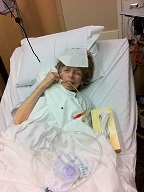Simulation and reality
The author recounts his mother's career as a simulated patient.
My mother, Arlene K. Newman, PhD, is a ham. Not the cured pork product, but the extrovert actress type. (It appears to be a genetic trait.)
Arlene's career as a simulated patient began in Galveston, Texas. Her stage was a hospital bed, where she lay, ostensibly after a minor procedure. As I rounded with medical students, I mentioned there was a very unhappy patient and family we needed to see, but to be careful since the husband (played by my father, Maurice) was a little crazy. I said I was concerned about violence. A linebacker-sized medical student leaned confidently towards me, his bulk implying “no problem.”

We walked in Arlene's room, where her husband promptly grabbed me by the lapels and threw me against the wall. Great method acting by Maurice. Arlene hid under the blankets pretending to cry, but she was really laughing, the chopped lettuce from her lunch drooling out of her mouth. Maurice glared at me. ‘How dare you,” he cried. The linebacker student was about to tackle my father, when again he said, “How dare you… come in this room without kissing your mother!”
Over the years, Arlene's acting improved. Fifteen years after her debut, with her method perfected, Arlene was employed at the Mayo Simulation Center as a standardized patient. It's great to be 82 when you get your first job. Her specialty was playing the role of a delirious patient named Mrs. Quincke, who is admitted from a nursing home with severe polypharmacy and delirium. She is on every Beers list drug. She also has pneumonia and sepsis from a urinary tract infection. She has pulled out her IV, yanked out her Foley catheter, and refused oxygen, blood draws, and examination. There is no family, and there are scant and confusing records.
The student's challenge? To control her behavior and get therapy started. Are drugs needed? Which ones? What dose and what are the side effects? Will she swallow a pill? What's her QT interval when you can't get an EKG? This is no easy task with Mrs. Quincke. She is cantankerous, tangential, and generally uncooperative.
Mrs. Quincke does not do well. The students hear a report from her alleged intern (played by me in a stylish mullet wig) reporting a frustrating night trying to manage her case. He made an attempt at oral haloperidol, then a more aggressive intramuscular dose, and then a risperidone dissolving dose. Still, she is aggressively delirious. When she bites a nurse, she gets put in restraints.
The students are called to see her the next morning, where she is found garroted by the very restraints meant to protect her (it's a mannequin and not my mother at this point). Attempts at resuscitation are unsuccessful. The subsequent day, her niece from Colorado arrives (played by a lawyer from the Mayo legal department) wanting to know what happened. Were protocols followed? Whose fault was it?
Arlene (the person, not the actress) has had her own medical trials and tribulations, which she has given me permission to write about. Her baseline health had been quite good, but as she hit her third year in Mayo employ and 85th year alive, she faced many orthopedic procedures complicated by hemarthrosis, urosepsis, and gastrointestinal bleeding. More recently, she had a stroke that left her with mild left-sided weakness, a pelvic and hip fracture, a temporal artery aneurysm, septic pulmonary emboli, delirium, and Clostridium difficile. Yet she still lives in her own apartment. Arlene is frail but feisty.
While I was in Abu Dhabi recently to give a talk about—of all things—the hospitalization of Mrs. Quincke (based on a literature review developed with Scott Keller, MD, FACP), I received a text from my all-star colleague, physician assistant Andy Herber. It read, “We are taking good care of your mother.”
“Oh (expletive),” I thought. “She must have been admitted to the hospital.” And I was on the other side of the globe, a 20-hour trip away at best. I was stunned. Was she unable to get up from a fall; did she have recurrent emboli? It could be anything.
Anxiously, I texted back, “What was she admitted for?” He replied back “Delirium.” I surmised it was recurrent sepsis. “How bad is she?” I wrote.
His response: “Dude, we are at the SIM center, she is working! LOL.”
Mrs. Quincke was gone, but Arlene was alive and well. Her patient act had become so convincing that even I was fooled.



